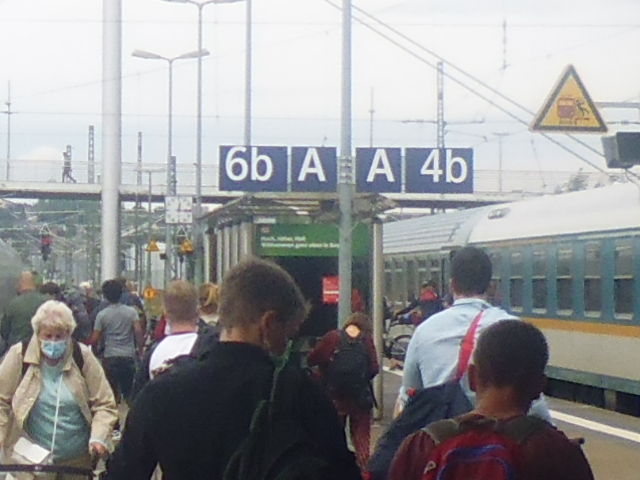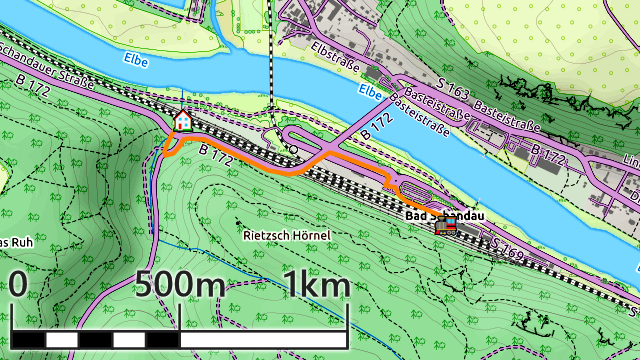Lengthwise through Bavaria
This should not only be our longest travel segment today, but also the longest travel segment on our entire journey, both in terms of time and distance. Now, as you probably recall, I like taking the slow trains when exploring the country. For one, I get to see much more of the land looking out of the windows. But much more importantly, taking regional trains is just so much more affordable. In fact, Germany offers something called the "Quer Durchs Land Ticket" ("Cross Country Ticket"), which allows free use of all regional trains in the entire country for a day and is actually ridiculously cheap, especially when used by multiple people. For example, this journey, taking the fastest possible connection, would have cost us a whopping 200€ normally, and even with the normal price for regional trains, it would still have been about 150€. However, with the Quer Durchs Land ticket, we only pay a total of 48,50€ the both of us together! That's only 24,25€ per person, a quarter of the fast connection, and a third of the regular fare. The only drawback of this offer is that we can only start our journey after 9:00 on weekdays. On the weekends and public holidays, however, there is absolutely no drawback to this amazing deal. Anyway, the first leg of our route today should take us north pretty much the entire length of Bavaria, and finally deposit us at the town of Hof, which is located in the alcove between Czechia, Saxony and Thuringia. Along the way, we should also pass through other notable cities and towns such as Landshut ("Land's Guard"), Regnieburg… sorry, Regensburg ("Rain Castle"), Schwandorf ("Swan Village") and Weiden ("Pastures"). After leaving the greater Munich metropolitan area, this ride takes us first through approximately 100 miles of farmland before forests start to get significantly more common some time after Regensburg. After that, we pass near a number of nature parks, such as the Oberpfälzer Wald ("Upper Palatinate Forest"), the Steinwald ("Stone Forest") and the Fichtelgebirge ("Spruce Mountains") before we eventually arrive in Hof, up there at the far end of Bavaria.In Hof, we only have a few minutes to get onto the next train. But fortunately (and quite honestly, amazingly) our train is on time, and conveniently, our next train is just standing on the opposite side of the platform we arrive on… …which is particularly curious, considering we arrive on platform 4 and depart from platform 6. Anyway, we manage to make our connection with time to spare, and are thus now on our way…
Across the Uplands
This time around we're travelling with a good old-fashioned Regionalexpress… though actually, it seems to be a pretty modern model. One curiosity here is that apparently in these parts of Germany, you don't have to buy the train ticket in advance, but can instead buy them inside the train, as long as you approach the conductor before sitting down. Since we already have our Quer-Durchs-Land Ticket, that does not apply to us, but I make a mental node of this protocol in case we need it at some point during our journey. Whereas our route thus far was relatively straight, from here on out it should become, in one word, crooked. While most of the long-distance trains cut right through the Central German Uplands, these local trains go over the top, or through river valleys, resulting in some rather interesting routings. The vast majority of this route should take us through Saxony, apart from the little bit of Bavaraia we still have to cross after Hof, and some very, very tiny corners of Thuringia we cross through in the uplands, where the crookedness of the border between Saxony and Thuringia exceeds that of the railroad track, cutting back and forth wildly for reasons lost to history. Along the path, we also come by towns and cities with such melodious names as Reichenbach ("Rich Stream"), Zwickau ("Pinch Ow"), Chemnitz ("Stone Stream") and Freiberg ("Free Mountain"). This time around, the track features a lot more woodlands, and naturally quite a couple of valleys. Also since the track is rather curvy, the train doesn't gather up quite as much speed as the alex before, making us travel at a somewhat more leisurely pace. Notably, the moment we leave Bavaria, we come across the first proper and very idyllic and modern wind park of our journey, and there's a good reason for that too: For some reason, the Bavarian government has imposed the moronic "10H-Rule" which states that no wind turbines may be built within a distance equal to ten-fold of their maximum height of any residential areas without explicit permission and excessive red tape. Fine by me, I would say, if that same rule also applied to factories and power plant, with the addition that for those explicit permission is also required from all communes that can potentially be affected by their emissions, and that this rule be applied retroactively for existing factories and power-plants. But oh well. It is also kinda noteworthy that our approach to Dresden is one of the very few and rare occasions that we should actually see rain fall on our entire journey around Germany.And then, we arrive in Dresden – capital of Saxony – amazingly right on time again, and with almost half an hour to change. Which is quite good, since Dresden turns out to be one of those more exciting stations. You see, while most stations have to decide on whether to be railhead stations or through stations, the Dresden Central Station went "Hey, whoever said I can't be both", and implemented this in an innovative two-layer design, where the inner seven tracks are on a lower level and terminate at the station, and an additional six tracks – three on each side – flank the terminus tracks on a higher level. And because that alone would still be boring, there's even an eight terminus track approaching the station from behind on the upper level. This level of unconventionality, as well as the architectural design of the station, make the Dresden Central Station to one of those really, really cool stations that I feel every traveler should at least spend a bit of transit time in on a Germany tour. One interesting measure against the Green Shnolz that I observe being put into place here is a load-chart displaying the estimated fullness of the S-Bahnen, which I imagine can be quite helpful in these times if you want to try and avoid getting stuck in crowded trains. Next to this, there's also a noticed about train timetable changes, which for some strange reason is horribly, horribly outdated, since it concerns only trains running on the 28th of April of this year. We have to wait for a little bit longer in this definitely cool station, and then we get to board what without a doubt is the chunkiest implementation of an S-Bahn that I have ever seen, featuring not only a fully-fledged 143-engine, but also double stack wagons. This is ye big olde grandma of all S-Bahnen! And with that, we embark on the final segment of today's train journey, leading us…
Up The Elbe
Compared to the previous two legs, this is only a relatively short segment, lasting only 45 minutes and taking us past towns and villages such as Heidenau ("Heath Meadow"), Obervogelgesang ("Upper Bird Song") and Königstein ("King Stone") the rest of the way to today's destination of Bad Schandau.The flat plains on which Dresden lies are soon enough replaced by the hills and mountains of the Sächsische Schweiz, rising up to both sides of the river Elbe, and whereas the S-Bahn at first makes a beeline through the landscape, it is eventually followed to closely follow the run of the river, winding its way further into the forested mountains past villages built along the very side of these hills.
We arrive at Bad Schandau under a threatening, yet thankfully dry sky. Despite bearing the impressive title of "Nationalpark-Bahnhof" ("National Forest Station"), this station really is little more than a few platforms with a building next to them. Anyway, here we are, at the destination of our first train journey. Or rather, we are almost at our destination, for the walk to our Airbnb Place should take us somewhat…

























No comments:
Post a Comment